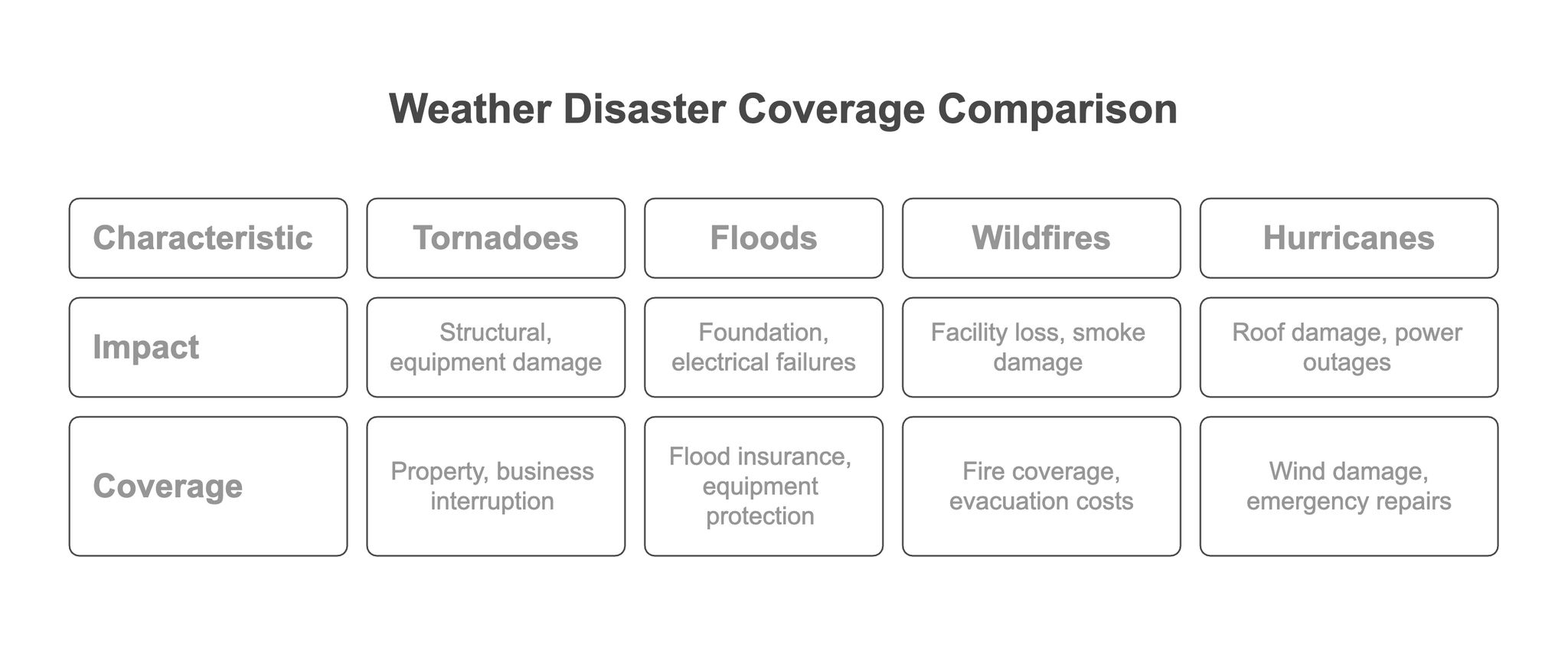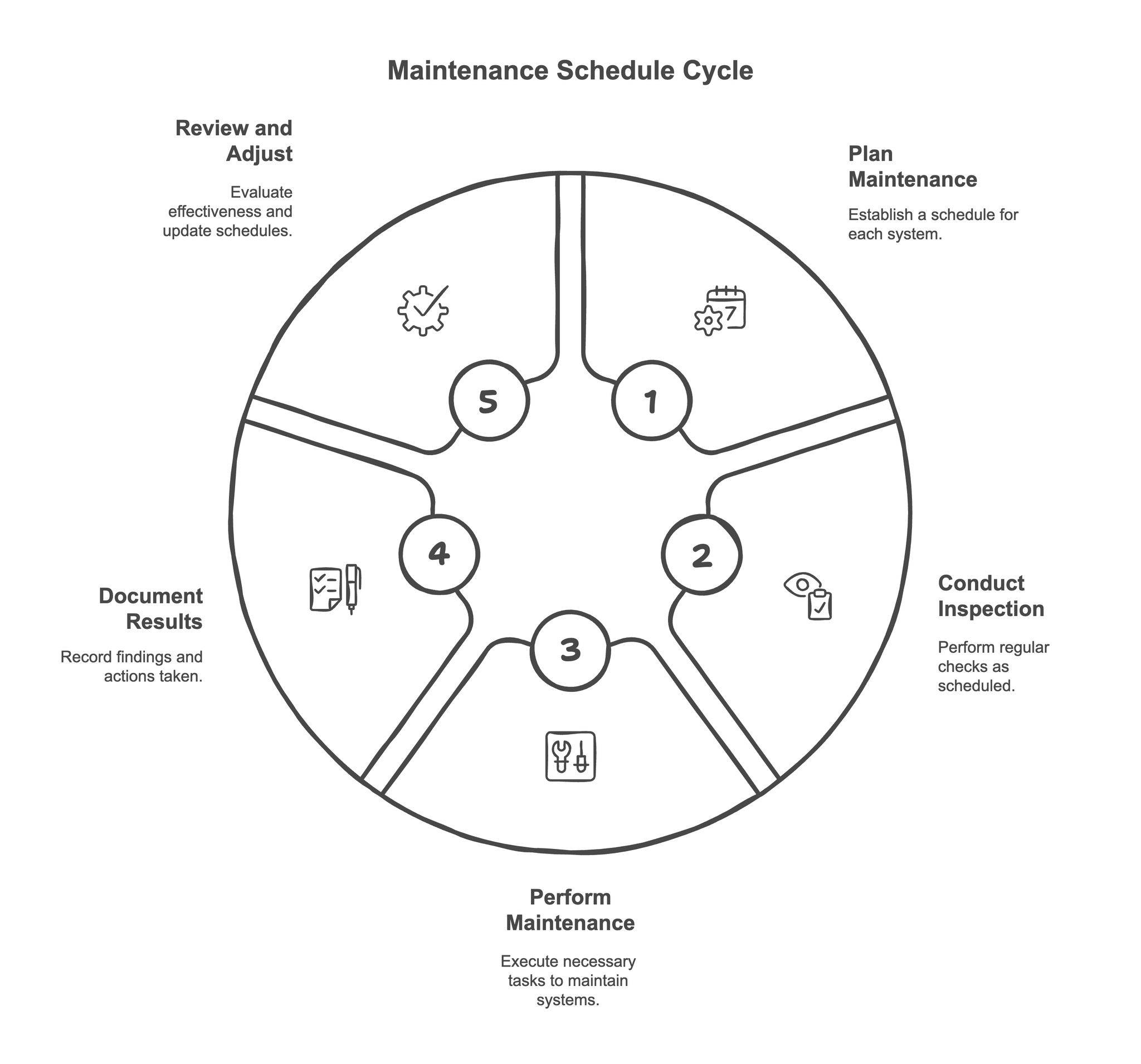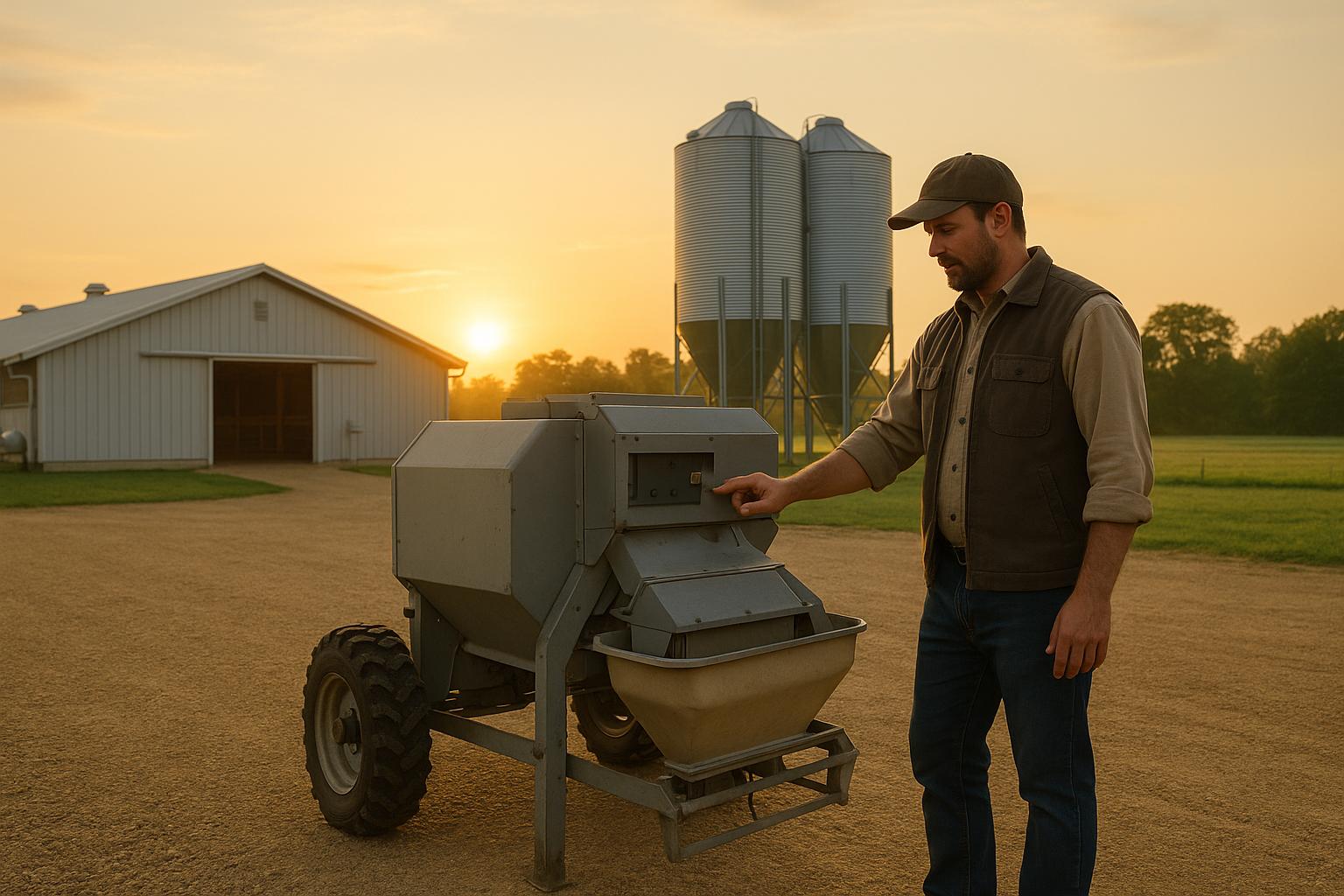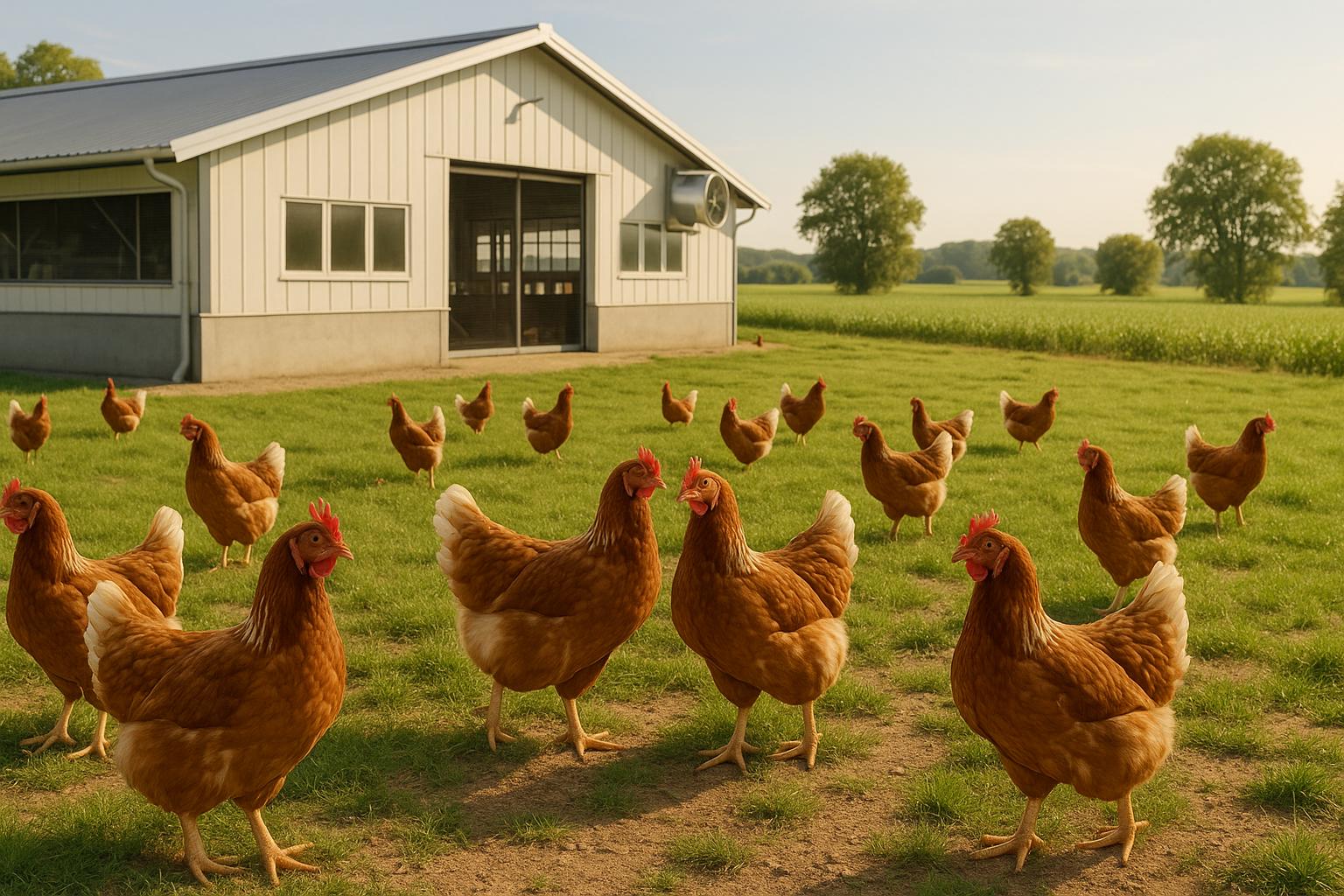Protect your poultry farm from costly disasters. Equipment failures, natural disasters, and power outages can disrupt operations and lead to financial losses. Yet, only 7.1% of poultry farmers have insurance. Here’s why coverage matters and what to insure:
-
Key Areas to Insure:
- Poultry houses: Protect against fire, severe weather, and structural damage.
- Feed and water systems: Cover breakdowns impacting bird health and production costs.
- Climate control systems: Insure ventilation, heating, and cooling equipment to maintain essential conditions.
- Backup generators: Ensure power outages don’t halt operations.
-
Risks Covered:
- Tornadoes, floods, wildfires, and hurricanes.
- Equipment breakdowns, including mechanical failures and power surges.
- Business interruptions due to disasters or system failures.
-
Maintenance and Compliance:
- Follow regular inspection schedules for equipment and structures.
- Meet safety standards to avoid coverage issues.
Insurance costs range from a few hundred to a few thousand dollars annually - far less than the potential losses from unexpected events. Secure your farm’s future by choosing tailored coverage.
Farm Equipment Insurance
Must-Insure Equipment and Structures
Having a well-rounded insurance plan is key to protecting every essential aspect of your farm. This ensures that your operations can continue smoothly, no matter what challenges arise.
Poultry House Protection
Your poultry houses are likely one of your biggest investments, and they need to be insured against risks like severe weather, fire, and natural disasters. In 2014, poultry operations made up 46.5% of cash agricultural receipts in Arkansas, highlighting their importance to the agricultural economy.
"Poultry farm insurance is designed to protect poultry or chicken farming operations from financial losses incurred due to damages to their poultry farm buildings and equipment, assets and tools, or the death, injury, or illness of their poultry animals." – Hitchings Insurance Agency
Beyond insuring the structures, it's important to also protect the systems that keep your poultry houses running efficiently, such as feed, water, and climate control systems.
Feed and Water System Coverage
Feed and water systems are the backbone of your operation, directly impacting bird health and accounting for over 60% of production costs. Insurance should cover equipment failures and supply interruptions. For specialized coverage, you might consider reaching out to Martin Agency, which has expertise in serving poultry farms across Arkansas, Missouri, and Tennessee.
Temperature Control Equipment Insurance
Maintaining the right environment in your poultry houses is non-negotiable, and that’s where climate control systems come in. Insurance should cover potential failures in ventilation, heating, and cooling equipment. To ensure uninterrupted operations, it’s also smart to insure your backup systems for added peace of mind during unexpected outages.
Emergency Generator Insurance
When power outages strike, backup generators are your lifeline, keeping critical systems operational. Insuring your generators can help cover repair costs and breakdowns during outages. Pairing this coverage with business interruption insurance can provide added protection against prolonged downtime.
Regular maintenance of your equipment, combined with the right insurance coverage, helps safeguard your farm against unexpected challenges.
Common Risks to Poultry Farms
Weather and Natural Disaster Coverage
Natural disasters can wreak havoc on poultry farms, damaging infrastructure and equipment in an instant. That’s why having insurance tailored to these risks is essential.
Here are some common weather-related threats and the types of coverage that can help:

While natural disasters are a major concern, mechanical problems can also disrupt operations and require immediate attention.
Equipment Breakdown Protection
Mechanical failures can bring a poultry farm to a standstill, making equipment breakdown insurance a must-have. Providers like Martin Agency offer policies designed to cover sudden and unexpected equipment failures.
This type of insurance typically includes:
- Costs for repairing or replacing damaged equipment
- Emergency replacements to minimize downtime
- Compensation for business interruption losses
For example, when a large egg production facility suffered a catastrophic loss of 5.3 million chickens, having the right insurance helped reduce the financial blow from both the direct damage and the resulting operational interruptions.
To ensure comprehensive protection, it’s important that policies also cover:
- Internal mechanical failures
- Damage caused by electrical arcing
- Malfunctions in control systems
- Power surge-related issues
- Failures in environmental control systems
Pairing regular maintenance with tailored insurance coverage helps keep operations running smoothly. Partnering with an insurance provider experienced in the unique demands of poultry farming ensures you’re prepared for whatever challenges come your way.
Meeting Insurance Requirements
Required Maintenance Schedules
Keeping your poultry farm equipment and structures in top shape isn’t just good practice - it’s a must for staying insured. Regular maintenance not only prevents breakdowns but also shows insurance providers that you’re managing your farm responsibly.
Here’s a quick look at what’s required:

What to document:
- Inspection dates and findings
- Repairs and parts replaced
- Service visits
- Equipment test results
By keeping detailed records and sticking to this schedule, you’ll not only maintain your farm’s efficiency but also ensure your insurance coverage isn’t jeopardized. And don’t forget - safety standards are just as important.
Safety Standards and Rules
Meeting safety standards is another cornerstone of maintaining insurance coverage. As Agriculture Secretary Tom Vilsack explains:
"USDA is creating a fairer, more competitive and transparent food system. This organic poultry and livestock standard establishes clear and strong standards that will increase the consistency of animal welfare practices in organic production and in how these practices are enforced."
Here are the key areas to focus on for safety compliance:
- Facility Standards: Make sure ventilation, lighting, and temperature controls meet animal welfare requirements.
- Health and Sanitation: Follow strict cleaning protocols and preventative measures, as outlined by FSIS.
- Emergency Preparedness: Maintain functional backup power systems and clear evacuation plans. Regular testing of emergency systems is highly recommended, as noted by Martin Agency.
To stay compliant:
- Schedule third-party inspections regularly
- Address any violations immediately
- Keep thorough documentation of safety procedures
- Train staff on protocols and emergency responses
- Record incidents and corrective actions
Routine inspections can catch small issues before they become big problems, helping you avoid coverage interruptions. By staying proactive, you can protect both your farm and your insurance policy.
Conclusion: Protecting Your Farm's Future
Getting insurance for your farm isn't just about following the rules - it’s about securing the future of your livelihood and legacy. Recent challenges, like the spike in egg prices due to avian influenza outbreaks, serve as a stark reminder of why having the right coverage is so important for staying prepared and resilient.
A solid insurance plan should include protection against:
- Equipment breakdowns
- Natural disasters
- Business interruptions
These key safeguards act as a safety net, but they’re just the start. To keep your coverage in step with your farm’s changing needs and the unique risks in Arkansas, Missouri, and Tennessee, it’s crucial to regularly review and fine-tune your policy. Experts at Martin Agency can help make sure you’re always prepared.
With the right coverage in place, you’ll protect your assets, maintain operations, and ensure your farm stays strong for generations to come.
FAQs
What types of insurance should poultry farmers consider to protect their equipment and structures?
To keep your poultry farm's equipment and structures protected, it's important to think about a few key types of insurance:
- Property Insurance: This covers damage to your poultry houses and other structures from events like storms, fires, or accidents. It ensures you can repair or replace damaged facilities without major financial strain.
- Equipment Breakdown Insurance: If critical systems like feeding, watering, or climate control equipment fail, this coverage helps cover repair or replacement costs, minimizing downtime and keeping operations running smoothly.
- Liability Insurance: This protects you financially if someone files a claim for bodily injury or property damage linked to your farm operations, shielding you from costly lawsuits.
Having these types of insurance in place can help reduce risks and keep your poultry farming operation on stable ground.
How does regular maintenance and following safety standards affect my poultry farm insurance?
Regular upkeep and strict attention to safety standards are essential when it comes to managing poultry farm insurance. By ensuring your equipment and buildings are well-maintained and sticking to safety protocols, you can significantly lower the chances of accidents, equipment breakdowns, or expensive insurance claims. This proactive mindset not only helps reduce risks but can also lead to more favorable insurance terms or even lower premiums, as it reflects a strong focus on managing potential hazards.
Routine inspections are another critical step. They allow you to catch small problems before they turn into big ones, helping to avoid costly downtime and major losses. Insurers tend to appreciate farms that emphasize safety and maintenance, which can make it easier to safeguard your investment and simplify the claims process should something unexpected occur.
What are the financial risks of not insuring my poultry farm's equipment and structures?
Not having insurance for your poultry farm’s equipment and structures can leave you vulnerable to hefty financial setbacks. If something goes wrong - like a feeding system breaking down or a poultry house suffering damage - you’re left to cover all the costs on your own. And let’s face it, those repairs or replacements can be pricey. Plus, the downtime from these issues could mean losing income, which only adds to the strain.
Then there are the bigger threats: storms, floods, fires, or even disease outbreaks. These can wreak havoc on your farm, leading to massive losses. Without insurance, every dollar needed for repairs, replacements, or recovery comes out of your pocket. This kind of financial pressure can put your farm’s future at risk. By investing in insurance, you’re not just protecting your equipment and structures - you’re safeguarding the stability and continued operation of your farm, even when the unexpected happens.




